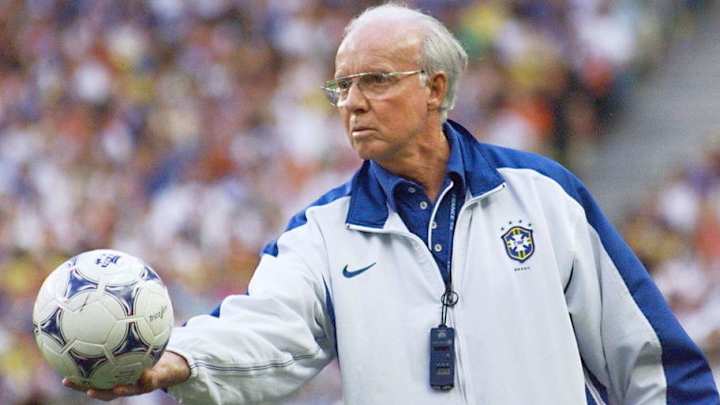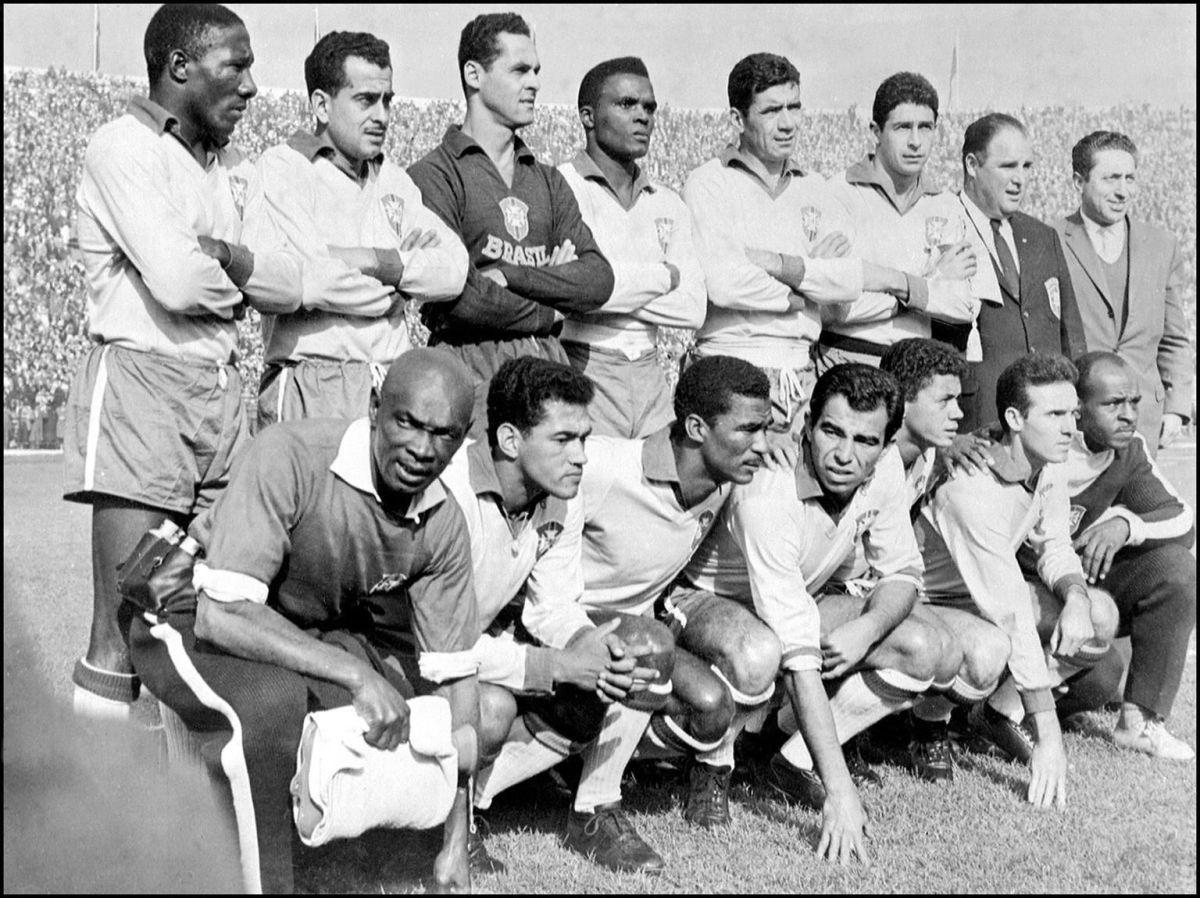World Cup Countdown: 15 Weeks to Go – Mário Zagallo, Four Times a Winner But Never a Fans' Favourite

Here’s your starter for ten: who scored Brazil’s five goals in the 1958 World Cup final? Most football fans should be able to tell you that Pelé got two of them, and a few more learned supporters would know that Vavá also chipped in with a brace. But a lot of people would be stumped as they tried to name the other one.
The forgotten man is Mário Zagallo, whose 68th minute goal gave Brazil a 4-1 lead and settled any remaining nerves. The 25-year-old had only made his debut for Brazil the previous month, but now, on the occasion of his ninth cap, he was a world champion.
A FIFA World Cup final is often the culmination of a career – the reward for years of hard toil. But the 1958 final was different. This was the beginning of Samba football, the beginning of Pelé’s ascent to greatness, and it was also the beginning of Zagallo’s World Cup odyssey.
Mário Zagallo was the first person to ever win the FIFA World Cup both as a manager and player. While many players dream of raising the World Cup one day, the Brazilian has lifted the trophy four times. Twice as a player, then again as manager and once more as assistant manager. pic.twitter.com/ky3xDJf5PH
— Challenger Recruitment (@challengercoach) February 3, 2018
(You may also be interested in 'World Cup Countdown: 15 Weeks to Go - The Welsh 'Gentle Giant' John Charles' 1958 Appearance')
Nowadays, Zagallo is remembered mostly for a statistic. With four World Cup winners' medals – two as a player, one as manager, one as a coach – the man they called the Little Ant is the most successful man in World Cup history. And yet, when it comes to remembering legends of Brazilian football, his name is usually found far down the list, if at all.
In an article last year, Daily Mail reporters were asked to name their favourite Brazilian footballer of all time. Ronaldo, Zico and Garrincha all showed up, as did Juninho, Mirandinha and even Lucas Leiva. Zagallo was nowhere to be found.
He was one of those players more fondly treasured by his team-mates than by the Brazilian fans or press, who valued flair above all else. Pelé and Vavá may have drawn all the plaudits for their prodigious goalscoring, but Zagallo’s versatility was arguably just as important to the Seleção’s success.
(You may also be interested in 'World Cup Countdown: 15 Weeks to Go - The Rise of Pele, the Starlet Who Became the Greatest Ever')
"Zagallo was the one who showed the world 4-3-3, who made it clear to all of us that a footballer must have two shirts - a defender's and an attacker's," said one of his compatriots. This was exemplified in the 1958 final, when Zagallo cleared the ball off the goal line at one end just minutes before he scored at the other.
It was only due to an immense stroke of fortune that Zagallo was playing at all. Santos legend Pepe, who famously described himself as "the greatest human striker in the history of Santos – because Pelé is from Saturn", was Brazil’s first choice to start up front alongside his club mate. A pre-tournament injury meant that his dream ended, and Zagallo’s was born.
Moving from a left wing position to that of a more conventional forward in 1962, Zagallo scored Brazil’s first goal in their opening game against Mexico and remained an ever-present throughout the tournament, which Brazil retained with a 3-1 win over Czechoslovakia in the final.

(You may also be interested in 'World Cup Countdown: 15 Weeks to Go - How the Munich Air Disaster Ended England's Chances in 1958')
Given his tactical awareness as a player, it was inevitable that Zagallo would go into management when he hung up his boots in 1965. After honing his skills at Botafogo, he returned to lead the national team, who had just suffered an embarrassing group stage exit in 1966.
Amidst the hysteria, Zagallo’s solution was evolution rather than revolution. The 4-3-3 that he had been a key proponent of in his playing days became 4-5-1, with Pelé and Jairzinho dropping deeper and Tostão operating as a loan striker.
Minor tweak it may have been, but it gave Brazil their mojo back, and they only got better as the 1970 tournament went on. The 4-1 win against Italy in the final, capped by Carlos Alberto’s magnificent team goal, is widely-considered to be one of the greatest performances ever seen at a World Cup.
Still Zagallo was not afforded any credit, with many dismissing his contribution, saying that any manager would have won the World Cup with such a squad at his disposal. When Brazil limped to a second round exit in 1974, the critics scuttered out of the woodwork to vilify the manager – Pelé among them. Zagallo caved under the pressure, and fell on his sword after the tournament.
Zagallo was just not the sort of figure to inspire great loyalty or affection. With his days as the Little Ant over, he had taken on a much less whimsical moniker in his managerial career: the Professor. He ran a tight ship, but his lack of outward passion meant that the Brazilian fans never warmed to him.
When Carlos Alberto Parreira took charge of Brazil in 1991, Zagallo was among the first appointments to his coaching team. His position was that of technical co-ordinator, allowing him to shape the team’s tactics without the pressure of the limelight.
The Brazil side that won in 1994 was a triumph of substance over style, scoring just eleven goals in seven games and conceding only three. "There is tactically nothing new in 1994,” a pragmatic Zagallo told reporters on the eve of the final. “The only lesson is that it is as important to play without the ball as it is with it. Teams must defend as well as they attack.”
Ronaldo and Mario Zagallo. pic.twitter.com/oms4YRGqnE
— 90s Football (@90sfootball) September 26, 2017
Brazil beat Italy on penalties to win their fourth World Cup, and only one man had been involved in every single one. Zagallo succeeded Parreira in the hotseat after the tournament and took a much-fancied Brazil side to the final in 1998, where they lost 3-0 to hosts France.
And, of course, the blame fell square on the shoulders of Zagallo, because that is the way of the world. The sky is blue, the Earth orbits the Sun, and Mário Zagallo gets blamed when things go wrong for Brazil.
Today, 12 years after his last involvement with the national team, public opinion on Zagallo has softened slightly. His achievements are better acknowledged, his reputation better respected. Acknowledged, respected…loved? Sadly, the World Cup’s most successful man was never destined for that. But his remarkable career deserves to be remembered for more than a mere statistic.
